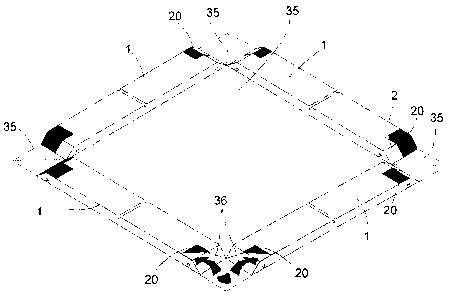Some of the information on this Web page has been provided by external sources. The Government of Canada is not responsible for the accuracy, reliability or currency of the information supplied by external sources. Users wishing to rely upon this information should consult directly with the source of the information. Content provided by external sources is not subject to official languages, privacy and accessibility requirements.
Any discrepancies in the text and image of the Claims and Abstract are due to differing posting times. Text of the Claims and Abstract are posted:
| (12) Patent Application: | (11) CA 2582853 |
|---|---|
| (54) English Title: | BRACING SYSTEM FOR CANVAS STRETCHER FRAMES |
| (54) French Title: | SYSTEME D'ENTRETOISEMENT POUR FAUX CADRES A TOILES |
| Status: | Deemed Abandoned and Beyond the Period of Reinstatement - Pending Response to Notice of Disregarded Communication |
| (51) International Patent Classification (IPC): |
|
|---|---|
| (72) Inventors : |
|
| (73) Owners : |
|
| (71) Applicants : |
|
| (74) Agent: | R. WILLIAM WRAY & ASSOCIATES |
| (74) Associate agent: | |
| (45) Issued: | |
| (22) Filed Date: | 2007-03-27 |
| (41) Open to Public Inspection: | 2008-09-27 |
| Availability of licence: | N/A |
| Dedicated to the Public: | N/A |
| (25) Language of filing: | English |
| Patent Cooperation Treaty (PCT): | No |
|---|
| (30) Application Priority Data: | None |
|---|
The present invention relates to the stretching of canvas or other flexible
materials on a stretching frame to be displayed without the use of a frame.
This
invention is designed to be sold as a kit which can be assembled by an
unskilled end
user without the use of stretching pliers and staplers (which require
considerable
strength and skill). The present invention allows for the tucking of the
corner folds of
canvas inside the mitered corners for a neater result than then the standard
stretching
systems available today. The finished product will have no side edge
fasteners,
unsightly corner folds or wrinkles.
Note: Claims are shown in the official language in which they were submitted.
Note: Descriptions are shown in the official language in which they were submitted.

2024-08-01:As part of the Next Generation Patents (NGP) transition, the Canadian Patents Database (CPD) now contains a more detailed Event History, which replicates the Event Log of our new back-office solution.
Please note that "Inactive:" events refers to events no longer in use in our new back-office solution.
For a clearer understanding of the status of the application/patent presented on this page, the site Disclaimer , as well as the definitions for Patent , Event History , Maintenance Fee and Payment History should be consulted.
| Description | Date |
|---|---|
| Application Not Reinstated by Deadline | 2011-03-28 |
| Time Limit for Reversal Expired | 2011-03-28 |
| Deemed Abandoned - Failure to Respond to Maintenance Fee Notice | 2010-03-29 |
| Application Published (Open to Public Inspection) | 2008-09-27 |
| Inactive: Cover page published | 2008-09-26 |
| Inactive: IPC assigned | 2007-11-23 |
| Inactive: IPC assigned | 2007-11-23 |
| Inactive: First IPC assigned | 2007-11-23 |
| Letter Sent | 2007-08-16 |
| Inactive: Single transfer | 2007-06-13 |
| Inactive: Courtesy letter - Evidence | 2007-05-01 |
| Inactive: Filing certificate - No RFE (English) | 2007-04-27 |
| Filing Requirements Determined Compliant | 2007-04-27 |
| Application Received - Regular National | 2007-04-25 |
| Small Entity Declaration Determined Compliant | 2007-03-27 |
| Abandonment Date | Reason | Reinstatement Date |
|---|---|---|
| 2010-03-29 |
The last payment was received on 2009-03-26
Note : If the full payment has not been received on or before the date indicated, a further fee may be required which may be one of the following
Please refer to the CIPO Patent Fees web page to see all current fee amounts.
| Fee Type | Anniversary Year | Due Date | Paid Date |
|---|---|---|---|
| Application fee - small | 2007-03-27 | ||
| Registration of a document | 2007-06-13 | ||
| MF (application, 2nd anniv.) - small | 02 | 2009-03-27 | 2009-03-26 |
Note: Records showing the ownership history in alphabetical order.
| Current Owners on Record |
|---|
| ARTEX PICTURE FRAMES LTD. |
| Past Owners on Record |
|---|
| PAUL VAZ |